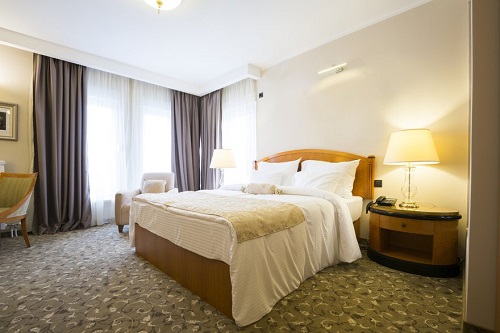
Being small also presents challenges when traveling, especially when staying in hotels. I can usually tell if I’m going to have problems in a hotel as soon as I see the bathroom. If the vanity comes up to my neck, I know I’m going to have a hard time leaning over the sink to wash my face at night. From there, I look to see how high up the bed is, and lament not bringing a grappling hook and rope in my carry-on.
No one, of course, can blame designers for not customizing every guestroom to people of different sizes. Designers have to work with averages, not extremes. But averages are changing. Women now account for approximately 47 percent of all business travelers (the type of traveler most likely to use a king room), and while the height of the average man in the U.S. is about 5-foot-9, the height of the average woman is about 5-foot-4. Those 5 inches can make a big difference when trying to reach a sink or climb into an elevated bed—and that’s just for averages, not for people at extreme ends of the height spectrum, or who face real physical challenges.
I remember a travel agent I met once who specialized in travel for people with disabilities. As a Little Person himself, he understood the challenges people can face when in hotels, and we bonded over similar problems. For me, climbing into an elevated bed is difficult. For him, it would be almost impossible. Climbing into or out of deep soaking tubs with especially wide edges and high walls was also challenging, he told me, and I knew exactly what he meant. As for reaching hangers in the closet—sometimes it works and sometimes it just isn’t worth the climb.
While most hotels have rooms that are compliant with the Americans with Disabilities Act, not every disability is the same—and of course, no designer can be expected to create rooms for every possible challenge a guest might face. But there are ways to make guestrooms more accessible for people with physical challenges, and they don’t have to involve heavy renovations. For starters, if a traveler is a member of a company’s loyalty program, it should be easy to note what kind of room he or she needs in the customer profile. These guests can be steered toward rooms with lower beds (and vanities) as soon as their reservation comes through the system. (At the other end of the spectrum, tall guests can be steered toward rooms with California King beds. They’ll appreciate the extra few inches.)
Designers can also make footstools part of the decor. Even a few extra inches can mean the difference between a comfortable stay and twisting an ankle when jumping out of a high bed. (Yes, this has happened. Several times.) If it isn’t practical to have footstools as a regular part of a hotel’s standard guestroom design, a hotel team can keep a few in storage and bring one to a room if the front desk agent thinks a guest might need it. At worst, it won’t be used—but at best, the stool can make a guest’s stay much more comfortable, and encourage positive reviews about the level of customer service the guest experienced.










Service Hotline
Work Time:Mon-Fri 9:00-18:00
UTC+8

Sinoexpo Digital Platform
Copyright 2006-2024 Shanghai Sinoexpo Informa Markets International Exhibition Co., Ltd. All rights reserved
沪ICP备05034851号-77
 沪公网安备 31010402000543号
沪公网安备 31010402000543号